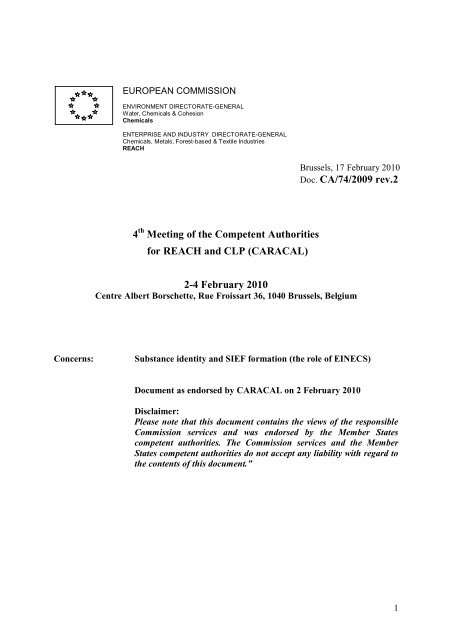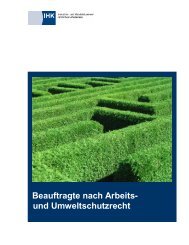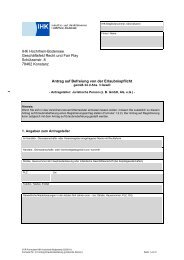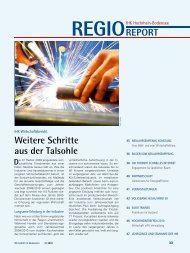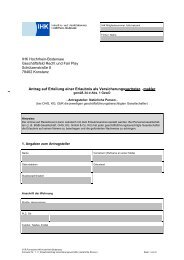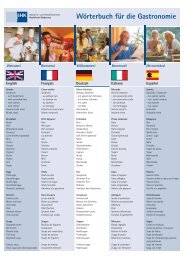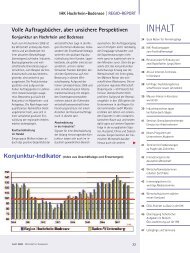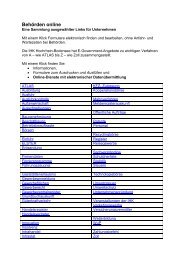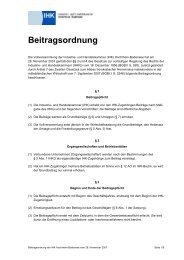REACH_One EINECs One SIEF_Final_clean
REACH_One EINECs One SIEF_Final_clean
REACH_One EINECs One SIEF_Final_clean
You also want an ePaper? Increase the reach of your titles
YUMPU automatically turns print PDFs into web optimized ePapers that Google loves.
EUROPEAN COMMISSION<br />
ENVIRONMENT DIRECTORATE-GENERAL<br />
Water, Chemicals & Cohesion<br />
Chemicals<br />
ENTERPRISE AND INDUSTRY DIRECTORATE-GENERAL<br />
Chemicals, Metals, Forest-based & Textile Industries<br />
<strong>REACH</strong><br />
4 th Meeting of the Competent Authorities<br />
for <strong>REACH</strong> and CLP (CARACAL)<br />
Brussels, 17 February 2010<br />
Doc. CA/74/2009 rev.2<br />
2-4 February 2010<br />
Centre Albert Borschette, Rue Froissart 36, 1040 Brussels, Belgium<br />
Concerns: Substance identity and <strong>SIEF</strong> formation (the role of EINECS)<br />
Document as endorsed by CARACAL on 2 February 2010<br />
Disclaimer:<br />
Please note that this document contains the views of the responsible<br />
Commission services and was endorsed by the Member States<br />
competent authorities. The Commission services and the Member<br />
States competent authorities do not accept any liability with regard to<br />
the contents of this document.”<br />
1
1. Introduction<br />
This document serves as a background note for the revised Q&A pair (no. 9.5) published on<br />
ECHA's website in the FAQs section.<br />
At the end of April 2009, ECHA submitted draft FAQ update 2.5 for written approval to<br />
REHCORN members. This update aims to complete the FAQ with a number of questions on<br />
substance identity and <strong>SIEF</strong> formation. <strong>One</strong> of the Q&A pairs proposed was FAQ no. 9.5<br />
(RHEP entry ID 872) relating to the issue whether pre-registrants of one EINECS entry<br />
should in all cases result form one <strong>SIEF</strong> or whether different <strong>SIEF</strong>s could be formed under<br />
certain circumstances.<br />
How is a Substance Information Exchange Forum (<strong>SIEF</strong>) formed?<br />
The Guidance on data sharing (Section 4.5 – How and when will a <strong>SIEF</strong> be formed?) explains how<br />
and when a <strong>SIEF</strong> will be formed and covers issues such as how to determine the sameness of<br />
substances, how to facilitate communication within a <strong>SIEF</strong> and at what point in time data holders<br />
should join the <strong>SIEF</strong>.<br />
All potential registrants and data holders for the "same" phase-in substance shall form a <strong>SIEF</strong>.<br />
However, the <strong>REACH</strong> Regulation does not define "sameness" and it does not foresee any formal role<br />
for ECHA in confirming the establishment of sameness or in the formation of a <strong>SIEF</strong>.<br />
The assessment of the exact nature of an EINECS entry and the different substances it may cover can<br />
only be carried out by the manufacturers or importers who are best placed to assess the composition of<br />
their substances. It is, therefore, up to them to take the responsibility for defining precisely the<br />
substance(s) for which a <strong>SIEF</strong> will be formed.<br />
In order to reach an agreement on the sameness of a substance, pre-registrants must enter into pre-<br />
<strong>SIEF</strong> discussions. As a consequence of this, a <strong>SIEF</strong> is formed when the potential registrants of a<br />
substance in the pre-registration list actually agree that they effectively manufacture or import or<br />
intend to manufacture or import a substance that is sufficiently similar to allow a valid joint<br />
submission of data.<br />
For further information in relation to pre-<strong>SIEF</strong>s and <strong>SIEF</strong>s please refer to the <strong>SIEF</strong> – Key Principles<br />
document.<br />
Within the helpdesk network no agreement could be found on the wording of the FAQ pair<br />
(more details on the consultation process can be found in Annex I). The Commission services<br />
considered that this matter is of an urgent and fundamental nature which requires discussion<br />
with the <strong>REACH</strong> Competent Authorities. Therefore, the Commission services have taken the<br />
initiative to raise this matter at the level of CARACAL. At the meeting of CARACAL on 12<br />
October 2009, this was briefly discussed. The Competent Authorities consider clarification of<br />
this matter as a priority and requested the Commission to urgently prepare a paper for<br />
discussion in writing and for endorsement by written procedure in the weeks following the<br />
meeting. The requested paper was submitted for written comments on 11 December 2009<br />
with a deadline for comments of 11 January 2010. This document integrates the comments<br />
received.<br />
2. Analysis of the legal provisions and the ECHA guidance<br />
2.1. <strong>REACH</strong><br />
2
Article 1(2) of <strong>REACH</strong> provides for that:<br />
“This Regulation lays down provisions on substances and mixtures within the meaning of Article<br />
3. These provisions shall apply to the manufacture, placing on the market or use of such<br />
substances on their own, in mixtures or in articles and to the placing on the market of mixtures.”<br />
(emphasis added)<br />
Article 3(1) of <strong>REACH</strong> defines a substance:<br />
“1. substance: means a chemical element and its compounds in the natural state or obtained by<br />
any manufacturing process, including any additive necessary to preserve its stability and any<br />
impurity deriving from the process used, but excluding any solvent which may be separated<br />
without affecting the stability of the substance or changing its composition;”<br />
For the purpose of registration, the identity of the substance needs to be established pursuant<br />
to Article 10(a)(ii) <strong>REACH</strong> read in conjunction with section 2 of Annex VI. Section 2 of<br />
Annex VI lists several identifiers with a view to sufficiently identifying a substance. Any<br />
substance needs to be identified by the relevant identification parameters:<br />
name or other identifier (section 2.1), information related to molecular and structural formula<br />
(section 2.2) and chemical composition (section 2.3). The EINECS (the European Inventory<br />
of Existing Commercial Substances) number is only one of the identifiers listed under section<br />
2.1. The EINECS number is listed under section 2.1.3 under the particular proviso “if<br />
available and appropriate” (emphasis added).<br />
This suggests that the substance is first identified and then the EINECS entry or entries are<br />
checked to determine if the substance is covered by the EINECS entry or entries.<br />
Annex VI Section 2 indicates the information requirements for substance identification. The<br />
Guidance for identification and naming of substances under <strong>REACH</strong> explains how this<br />
information should be interpreted and a proper and unambiguous substance name should be<br />
derived.<br />
Moreover, the historic and legal context under which the EINECS was established is<br />
important. EINECS lists substances, which were on the Community market between 1971 and<br />
1981 and therefore regarded as existing substances which had no obligations to be notified<br />
under Directive 67/548/EEC and hence it was rather necessary to be comprehensive but not<br />
necessarily to be very exact in the differentiation between individual substances in a single<br />
EINECS entry, as long as it was clear which substance(s) or group of substances were<br />
considered to be exempted from the notification obligations. Furthermore the reporting rules<br />
for EINECS were different from the rules which should be applied under <strong>REACH</strong>. Therefore<br />
some EINECS entries are very broad and strictly speaking cover more or even groups of<br />
substances rather than individual substances. Moreover, there are also other cases, where<br />
several EINECS entries cover one and the same substance. In those cases, such substances<br />
should be dealt with as the same substance under <strong>REACH</strong>.<br />
In conclusion, for the purpose of substance identification and consequently <strong>SIEF</strong> formation,<br />
the relevant legal provisions in <strong>REACH</strong> are the substance definition in Article 3(1) of<br />
<strong>REACH</strong> and the identification requirements set out in Annex VI.<br />
EINECS serves two purposes:<br />
3
1. The reference to EINECS in Article 3(20) <strong>REACH</strong> is relevant in the context of the<br />
specific definition of “phase-in substance”, which, in turn, has relevance for the<br />
transitional provisions in <strong>REACH</strong> applicable for phase-in substances. The EINECS<br />
listing is thus relevant for legally determining the phase-in status of a substance and<br />
the ensuing registration deadline, as all substances covered by an EINECS entry<br />
qualify as phase-in substances.<br />
2. EINECS in the vast majority of entries lists one substance and only in certain cases<br />
cover more than one substance. EINECS therefore assists the vast majority of<br />
registrants to efficiently identify their substance and to work with others to determine<br />
if they in fact manufacture or import the same substance.<br />
2.2. The Guidance<br />
The substance definition and the identification rules are further explained in the Guidance for<br />
identification and naming of substances under <strong>REACH</strong> 1 and the Guidance on data sharing 2 .<br />
These guidance documents constitute main interpretative instruments which should be taken<br />
into account in decisions on substance identity and <strong>SIEF</strong> formation. These documents were<br />
initially developed by the Commission in close cooperation with Member States and industry<br />
stakeholders and eventually endorsed by the working group comprising competent authorities<br />
of all Member States, representative number of industry associations and NGO’s. As these<br />
documents have been used as a basis for the work of <strong>SIEF</strong>s so far, any change in<br />
interpretation would likely lead to confusion and the need to revert some of the co-operation<br />
already established. The main references in the guidance to the status of EINECS in relation<br />
to substance identification and data sharing are recalled in Annex II.<br />
3. Practical consequences and need for further work<br />
3.1. Cross-relationship between substances, <strong>SIEF</strong>s and data sharing obligations and<br />
their relationship to EINECS numbers<br />
Most <strong>REACH</strong> obligations apply to substances as defined in Article 3(1). <strong>REACH</strong> starts from<br />
the assumption that registrants are aware of this definition and correctly apply it (using the<br />
identification parameters set out in section 2 of Annex VI). <strong>REACH</strong> does not provide further<br />
mechanisms to determine substance identity. Failure to correctly identify substance identity<br />
affects the basis for data sharing within <strong>SIEF</strong>s and may result in preparation and submission<br />
of incomplete registration dossiers. This may violate a number of <strong>REACH</strong> provisions, which<br />
are described in more detail below.<br />
In practice, determining substance identity often is far from straightforward and for these<br />
reasons, guidance has been elaborated on the criteria to be applied and recommending a<br />
number of steps to companies to agree on substance identity within pre-<strong>SIEF</strong>s, as a basis for<br />
data sharing. This may in certain cases lead to splitting EINECS entries into several distinct<br />
substances. As <strong>REACH</strong> foresees one <strong>SIEF</strong> per substance, this means that the pre-<strong>SIEF</strong> is split<br />
into several <strong>SIEF</strong>s.<br />
1 http://guidance.echa.europa.eu/docs/guidance_document/substance_id_en.pdf<br />
2 http://guidance.echa.europa.eu/docs/guidance_document/data_sharing_en.pdf<br />
4
Obligatory data sharing under <strong>REACH</strong> is limited to the same substance and does not apply<br />
between different substances. Nevertheless, data sharing and read-across are also encouraged<br />
between different substances, wherever this is possible and scientifically sound. Therefore,<br />
wherever EINECS entries are split up into several <strong>SIEF</strong>s and despite the fact that data sharing<br />
is only obligatory within the <strong>SIEF</strong>, it is still advisable to consider whether data sharing and<br />
read-across could not also apply between the different substances previously covered by the<br />
same EINECS entry. As explained further in section 3.4, this may help preventing possible<br />
violations of data sharing obligations in cases of doubt and even in cases where EINECS<br />
entries have been incorrectly split.<br />
3.2. Criteria to be applied in case of doubt<br />
Determining the sameness of a substance is a very critical step. The criteria to be applied are<br />
described in the guidance on identification and naming of substances (see above). ECHA has<br />
received several dossiers where the substance identity is not sufficiently elaborated, for<br />
example when splitting one EINECS entry into several substances, the substance identity in<br />
cases of varying composition of UVCB substances, e.g. EINECS entries for extracts covering<br />
tinctures, concretes, absolutes, essential oils, oleoresins, terpenes, terpene-free fractions,<br />
distillates, residues which have due to refinement steps different compositions, or merging of<br />
several EINECS entries into one substance, e.g. Amines, C12-18-alkyl (EINECS number 268-<br />
953-7) with Amines, hydrogenated tallow alkyl (EINECS number 262-976-6) . However, this<br />
will require more analysis and cannot be done within the scope of this paper. This will<br />
therefore be done in a separate document.<br />
Registrants should in a first step assess whether there is a clear reason to split up EINECS<br />
entries. This is in particular the case where an EINECS entry covers different chemical<br />
identities under one and the same EINECS entry. UVCB substances, in particular, are often<br />
defined very broadly though the individual substances which are covered by such an entry<br />
may be different because of the different production processes are used or the different<br />
substances are much more narrow in definition.<br />
However, quantitative variations of impurities or quantitative variations of the fractions of the<br />
main constituents of defined substances within certain limitations do not lead to a different<br />
substance identity, even though the resulting substance properties might differ and these<br />
differences need to be documented in the registration dossier. In such cases, it is essential that<br />
the information provided is sufficient to cover the properties of all variants of the substance<br />
(i.e. testing should be done on the most hazardous variants or in a way to allow a sufficiently<br />
robust extrapolation on properties to be expected in case of variation of composition of<br />
substances).<br />
Wherever an EINECS entry has been split up into several substances, it is strongly<br />
recommended to provide clear documentation giving a scientifically-based justification why<br />
this has been done. On the other hand, in cases where there can be doubts on substance<br />
identity, it is also necessary to justify why an EINECS entry has not been split, to avoid<br />
problems in the further assessment of the dossier.<br />
3.3. Specific considerations for recovered substances<br />
Also, in many cases recovered substances have a different impurity profile than substances<br />
manufactured from primary materials. This does not necessarily mean that they are different<br />
5
substances for the purpose of <strong>REACH</strong>. More information can be found in the Commission<br />
document on <strong>REACH</strong> and waste and recovered substances 3 .<br />
3.4. What happens if EINECS entries have been incorrectly split into several<br />
substances<br />
There have been reports that companies within pre-<strong>SIEF</strong>s have used a very narrow<br />
interpretation of the substance definition to keep other companies and in particular SMEs out<br />
of the data sharing process, thereby making it very difficult and costly for these companies to<br />
prepare their own registration dossiers. This may violate <strong>REACH</strong> and Community legislation<br />
in various ways.<br />
On the one hand, this practice violates data sharing obligations with potentially serious<br />
consequences under <strong>REACH</strong>. In particular, it should be understood that, in line with Article<br />
30(3), refusal to provide data which involves testing on vertebrate animals on request results<br />
in inability to register substances and therefore in the extreme case the inability to continue<br />
manufacturing or importing the substance. Article 30(6) specifically requires the penalisation<br />
in accordance with Article 126 of the owner of the study who has refused to provide either<br />
proof of the cost or the study itself, i.e. the need for penalisation is emphasised in case of this<br />
particular breach.<br />
On the other hand, such a practice – whether the relevant substance involves testing on<br />
vertebrate animals or not – may, if it has the object or effect of excluding other companies<br />
from the relevant market as established in accordance with the Community legislation in the<br />
field of competition, constitute a violation of EU competition law and may therefore be<br />
prohibited and give rise to fines imposed under the EU competition rules.<br />
Companies facing doubts on whether they can or should split up EINECS entries should<br />
therefore take a cautious approach with respect to data sharing. On the one hand, substance<br />
identification criteria should be analysed very carefully and splitting up EINECS entries<br />
should be avoided where this is not justified. On the other hand, wherever it is concluded that<br />
splitting up EINECS entries is necessary, it may be scientifically appropriate to apply data<br />
sharing and read-across nevertheless to the entire group of substances, which will also help to<br />
avoid violation of data sharing obligations in case a mistake has been made, and it is found<br />
later on by authorities that the EINECS entry should not have been split.<br />
Companies facing situations where other companies manufacturing or importing the same<br />
substance refuse access to data with the argument that their substance is different are strongly<br />
recommended to formally request those data in line with Article 30(1) <strong>REACH</strong>. If the owner<br />
of the data refuses to provide the data, this has as a consequence that, provided it involves<br />
vertebrate animal testing, the data owner cannot register the substance and that, the company<br />
who is refused access to the data can proceed to register the substance without fulfilling the<br />
relevant information requirement. (The Agency may decide within 12 months of the date of<br />
such registration, if the owner of the information has not provided access to the requestor, that<br />
the test must be repeated by them.)<br />
3 http://ec.europa.eu/enterprise/sectors/chemicals/files/reach/waste_paper_ca_090403_en.pdf<br />
6
However, such situations should be avoided as far as possible. Therefore, it is recommended<br />
that companies take a cautious approach with regard to data sharing obligations. If conflicts<br />
on the scope of data sharing on the basis of different interpretation of substance identity<br />
appear unavoidable, it may be useful that concerned companies contact ECHA with a view of<br />
resolving this conflict before submission of registration dossiers.<br />
3.5. Incorrect submission of dossiers covering several substances<br />
On the other hand, where splitting up of EINECS entries into several substances is justified on<br />
the basis of the substance identification criteria, failure to do so can also have serious<br />
consequences, because <strong>REACH</strong> foresees that one registration is made per substance.<br />
If a registration dossier incorrectly covers several substances, the registration can be<br />
considered as valid at most for one of those substances or if it is unclear which of the<br />
substances is covered, the registration may be considered as invalid for all substances it was<br />
intended for. In this case, manufacturing and importing of all substances which are not<br />
covered may have to be stopped (except where the relevant registration deadline has not yet<br />
expired), new registration dossiers must be submitted and a (new) fee must be paid for each of<br />
those substances.<br />
The background to these considerations and their underlying provisions in <strong>REACH</strong> is that the<br />
hazards and risks of substances should in all cases be properly assessed and controlled. This is<br />
not the case if only one of several substances covered by an EINECS entry (or one of several<br />
variants of the same substance) is tested and where extrapolation of data is not sufficiently<br />
robust. Therefore, while it is recommended that in case of doubt rather several separate<br />
dossiers are submitted than one dossier that is too broad, it should in all cases and even in<br />
cases where EINECS entries are not split up be taken care that the submitted data cover all<br />
substances or variants of the same substance. In case of serious doubts on the approach to<br />
follow, ECHA should be contacted to resolve problems before submission of the dossier.<br />
Further details on what happens upon submission of dossiers with unclear and/or<br />
insufficiently addressed substance identity still need to be elaborated and will be addressed<br />
separately in a planned paper.<br />
3.6. What can companies do in case of doubt?<br />
As described above, incorrect definition of substance identity can have serious consequences.<br />
Refusal to share data within <strong>SIEF</strong>s upon a request based on Article 30(1), if it concerns data<br />
involving testing on vertebrate animals, may lead to inability to register the substance for the<br />
owner of that data. Failure to split EINECS numbers into several substances may result in<br />
invalid registrations, the need to prepare and re-submit registration dossiers for all concerned<br />
substances and to pay the registration fee again. Therefore, in case of doubt, it is<br />
recommended to share data as widely as possible within the group of companies having preregistered<br />
with the same EINECS entry (even if this is not strictly required by <strong>REACH</strong>) and,<br />
at the same time, to interpret the substance definition narrowly, i.e. to rather submit several<br />
separate dossiers. Wherever a decision is taken not to split EINECS entries, care should be<br />
taken that the data submitted are adequate for all variants and forms of the substance. In case<br />
of major problems, it is advised to contact ECHA to seek clarification.<br />
7
4. Conclusions<br />
The identity of the substance under <strong>REACH</strong> needs to be established on the basis of Article<br />
3(1) definition using the identifiers enumerated in section 2 of Annex VI <strong>REACH</strong>. These<br />
provisions are further interpreted in the Guidance on substance identification. This guidance<br />
refers to the EINECS reporting rules as a basis for identification and naming of substances.<br />
As in most cases, the EINECS reporting rules should be correctly reflected in EINECS, one<br />
EINECS entry should in those cases correspond to one substance under <strong>REACH</strong>. Also, a<br />
different impurity or hazard profile due to other reasons than those determining substance<br />
identity does not necessarily mean that identities of substances are different.<br />
In accordance with the <strong>REACH</strong> legal text and the Guidance on substance identification the<br />
EINECS number is an identifier for substance identification, but it does not alone determine<br />
substance identity, as other identifiers have to be taken into account. Therefore, one EINECS<br />
entry may correspond to two or more different substances. In those cases different <strong>SIEF</strong>s<br />
should be formed and joint submissions must be submitted for more precisely defined<br />
substances. Although this is more likely to occur for UVCB substances, this in principle<br />
applies also to ‘well-defined’ substances, as the substance definition in <strong>REACH</strong> does not<br />
distinguish between these two substance types. There can also be cases where several<br />
EINECS entries may correspond to one and the same substance for the purpose of <strong>REACH</strong>.<br />
In <strong>REACH</strong>, the EINECS listing is relevant mainly for determining the phase-in status of a<br />
substance (Article 3(20)). In cases where one EINECS entry corresponds to two or more<br />
different substances, all substances previously covered by that entry qualify as phase-in<br />
substances.<br />
In the process of data sharing, the first step of <strong>SIEF</strong> formation will be the establishment of the<br />
sameness of the substance within the <strong>SIEF</strong>. This is a process which takes place among the<br />
potential registrants, and there is at this stage no confirmation or rejection by ECHA or the<br />
Commission. In establishing the sameness, the potential registrants must respect the substance<br />
identity rules as established by <strong>REACH</strong>. These rules are further interpreted in the substance<br />
identification guidance, which should be used as the main interpretative tool. Companies<br />
should be aware that any decisions on sameness which are not in line with <strong>REACH</strong><br />
requirements may be challenged by the authorities.<br />
Such challenges may have serious consequences for the legality of registration dossiers. If<br />
EINECS entries are incorrectly split up and data sharing is refused on this basis after a request<br />
for data on the basis of Article 30(1) has been made, this results, in case it involves testing on<br />
vertebrate animals, in the inability of the registrant who refuses data sharing to register the<br />
substance. In any case, the refusal to provide studies on request should be penalised. On the<br />
other hand, incorrect registration dossiers covering several substances may be considered noncompliant<br />
and companies may have to prepare and submit new registration dossiers for each<br />
substance and pay the fee again. A possible way out in case of doubt is to interpret the<br />
substance identity narrowly, i.e. in case of doubt rather prepare several registration dossiers<br />
but nevertheless apply the data sharing obligations widely, i.e. to share data and apply readacross<br />
within the entire group of companies which pre-registered with this EINECS entry. In<br />
case of doubt, it is also recommended to contact ECHA in order to avoid problems after<br />
submission of the dossier.<br />
8
Based on these conclusions, the Commission services propose to rephrase the Q&A pair in<br />
question as follows:<br />
How is a Substance Information Exchange Forum (<strong>SIEF</strong>) formed and what is the role of EINECS<br />
in defining substance identity?<br />
The Guidance on data sharing (Section 4.5 – How and when will a <strong>SIEF</strong> be formed?) explains<br />
principles on how and when a <strong>SIEF</strong> will be formed and how to determine the sameness of substances<br />
(i.e. whether the quantitative and qualitative composition of a substance leads to the conclusion that it<br />
needs to be considered as one and the same substance with one name for the purpose of <strong>REACH</strong>) and<br />
therefore whether they should be considered together in one <strong>SIEF</strong>. The Guidance also explains how to<br />
facilitate communication within a <strong>SIEF</strong> and at what point in time data holders should join the <strong>SIEF</strong>.<br />
All potential registrants for the same phase-in substance shall form a <strong>SIEF</strong> on the basis of the rules laid<br />
down in <strong>REACH</strong> and further explained in the Guidance for identification and naming of substances<br />
under <strong>REACH</strong>. Wherever a phase-in substance has an EINECS number, this will normally mean that<br />
one <strong>SIEF</strong> will be formed for one EINECS entry. However, one EINECS entry may also correspond to<br />
several substances or several EINECS entries may correspond to one and the same substance.<br />
Establishing substance identity and determining whether substances should be considered the “same”<br />
substance and join the same <strong>SIEF</strong> is the matter for “sameness” discussions which should take place<br />
before a <strong>SIEF</strong> is formed. It should be noted that the <strong>REACH</strong> Regulation does not define "sameness"<br />
and it does not foresee at this stage any formal role for ECHA in confirming the establishment of<br />
sameness or in the formation of a <strong>SIEF</strong>.<br />
In order to reach an agreement on the sameness of a substance, pre-registrants must enter into pre-<br />
<strong>SIEF</strong> discussions. As a consequence of this, a <strong>SIEF</strong> is formed when the potential registrants of a<br />
substance in the list of pre-registered substances actually agree that they effectively manufacture or<br />
import or intend to manufacture or import the same substance to allow a valid joint submission of data.<br />
Any decision on the substance’ identity and substance name should be carefully examined to ensure<br />
that they are in line with the <strong>REACH</strong> substance identity rules explained in the Guidance for<br />
identification and naming of substances. Refusal to share data within <strong>SIEF</strong>s may under certain<br />
circumstances lead to inability to register the substance. Failure to split one EINECS entry into several<br />
substances, where necessary, may result in invalid registrations, the need to prepare and re-submit<br />
registration dossiers for all concerned substances and to pay the registration fee again. Therefore, in<br />
case of doubt, it is recommended to share data as widely as possible within one EINECS entry (even if<br />
this is not strictly required by <strong>REACH</strong>) and, at the same time, to interpret the substance definition<br />
narrowly, i.e. to rather submit several separate dossiers. Wherever a decision is taken not to split<br />
EINECS entries, care should be taken that the data submitted are adequate for all variants and forms of<br />
the substance.<br />
In case of major problems, it is advised to contact ECHA to seek clarification.<br />
For further information in relation to pre-<strong>SIEF</strong>s and <strong>SIEF</strong>s please refer to the <strong>SIEF</strong> – Key Principles<br />
document and to document CA/74/2009 rev.2 (available on<br />
http://ec.europa.eu/enterprise/sectors/chemicals/files/reach/substance_identity_sief_formation_en.pdf).<br />
9
Annex I: Details of the consultation procedure in the helpdesk network<br />
In the written procedure (2 nd step) launched on 9 June 2009, ECHA summarized the<br />
comments received on this Q&A pair. In essence, PL and AT agreed, SK, BE proposed<br />
redrafting, and DE proposed to delete the pair. ECHA proposed to discuss this Q&A pair at<br />
the next REHCORN meeting.<br />
On 19 June 2009, DE replied that it still has substantial concerns with this Q&A pair. It<br />
argued that a <strong>SIEF</strong> is not formed when the potential registrants of a substance in the preregistration<br />
list actually agree that they effectively manufacture or import or intend to<br />
manufacture or import a substance that is sufficiently similar to allow a valid joint submission<br />
of data but that a <strong>SIEF</strong> is formed if the substances are identical. At the next level the<br />
companies of the same substances have then to decide whether a test conducted with a<br />
substance with a specific composition (impurity profile, purity) can be used for the same<br />
substances however having different impurity profiles and purities. DE proposed to discuss<br />
this matter at the October REHCORN meeting.<br />
In further comments sent on 30 June 2009, reacting to a UK example on orange extract, DE<br />
further specified its considerations, underlining that according to its opinion one EINECS<br />
entry defines only one <strong>SIEF</strong>. It considers that this principle is laid down in the ECHA<br />
guidance on substance identification and applies both to well defined and UVCB 4 substances.<br />
ECHA replied to the DE on 30 June 2009, underlining that the <strong>REACH</strong> substance definition<br />
does not contain a reference to EINECS, and that both the guidance on substance<br />
identification and the guidance on data sharing clearly mention that a substance as defined by<br />
an EINECS entry is not necessarily identical to a substance under <strong>REACH</strong>.<br />
In a further reply of 5 August 2009, DE accepted the possibility that the rule ‘one EINECS<br />
number = one substance’ may not be applied to some UVCB substances as these substances<br />
are more complex but insisted that the rule ‘one EINECS number = one substance = one<br />
<strong>SIEF</strong>’ should apply to all substances with a well defined composition, regardless whether they<br />
are mono-constituent or defined multi-constituent substances (in the latter case substances can<br />
also be defined by the EINECS numbers of their main constituents).<br />
Following this exchange of e-mails, the Commission services have suggested raising this<br />
matter at the level of CARACAL.<br />
4 Substances of Unknown or Variable composition, Complex reaction products or Biological materials<br />
10
Annex II: Main references in the guidance to the status of EINECS in relation to<br />
substance identification and data sharing<br />
1. Guidance for identification and naming of substances under <strong>REACH</strong> (Guidance on<br />
substance identification)<br />
1.1. Rules for all types of substances<br />
The guidance confirms that the checking of the sameness of the substance is based on<br />
EINECS reporting rules but at the same time clearly refers to the possibility to divert from the<br />
EINECS listing in certain justified cases.<br />
[The EINECS reporting rules] “which were applied for establishing EINECS [Manual of<br />
Decisions, Criteria for reporting substances for EINECS, ECB web-site; Geiss et al. 1992,<br />
Vollmer et al. 1998, Rasmussen et al. 1999] should be regarded as a common base for identifying<br />
and naming a substance and thus finding a potential co-registrant of this particular substance. In<br />
the following paragraphs guidance for identifying and naming substances is given. Substances<br />
which are not regarded as the same may, however, be regarded as structurally related by<br />
application of expert judgement. Data sharing might, nevertheless, be possible for these<br />
substances if scientifically justified. However, this is not subject of this TGD, is addressed in RIP<br />
3.4 Data Sharing.” (section 5, p. 46)<br />
The guidance also confirms:<br />
“A substance is completely identified by its chemical composition, the chemical identity and the<br />
content of each constituent in the substance. Although such straight-forward identification may<br />
be possible for most substances, for certain substances it is not feasible or not adequate within<br />
the scope of <strong>REACH</strong>. In those cases, other or additional substance identification information is<br />
required.” (section 4.1, p. 18).<br />
It should be noted that, in interpreting the substance definition and the identification rules, the<br />
guidance refers to the EINECS reporting rules as a basis for identification and naming of<br />
substances but not to the EC list as such. Even though in many cases the result of applying<br />
these rules will be the same (and it will be useful not to reopen discussions unless there is a<br />
major reason to do so), there may be cases where the result of a refined analysis or new<br />
information may be to define substances differently than in the EC list.<br />
On the nature of EC lists, the guidance confirms their limited role, related to the phase-in vs.<br />
non phase-in status of the substance, as follows:<br />
“The EC Inventory can be used as a tool for manufacturers and importers to decide whether a<br />
substance is a phase-in substance or a non-phase-in substance. Thus, the EC Inventory will help<br />
manufacturers and importers to find out when the registration of a substance will be required,<br />
and if a pre-registration or an inquiry is necessary.” (section 3.2.1, p. 15)<br />
The possibility of different substance identification, compared to EINECS, under the new<br />
<strong>REACH</strong> inventory to be created by ECHA, after entry into force of <strong>REACH</strong> is referred to:<br />
“The registration process allows the new inventory of registered substances to “correct” the<br />
current EINECS, where “mistakes” were made.” (section 3.2.2, p. 15-16)<br />
The guidance subsequently describes the possibility of imprecision of certain broad EINECS<br />
entries:<br />
“Sometimes the description of a substance in EINECS is relatively broad. In these cases, the<br />
potential registrant is invited to describe the substance in question more precisely (e.g. via the<br />
IUPAC name or other identifiers). To benefit from the phase-in rules, the registrant should<br />
11
nevertheless indicate to which EINECS entry the substance belongs. In such cases, the European<br />
Chemicals Agency will decide whether or not it is appropriate to allocate a new EC number to<br />
the substance in question.” (section 3.2.2, p. 16)<br />
In its mail of 19 June, DE also argued that “a <strong>SIEF</strong> is formed if the substances are identical.<br />
At the next level the companies of the identical substances have then to decide whether a test<br />
conducted with a substance with a specific composition (impurity profile, purity) can be used<br />
for the identical substances with different impurity profiles and purities. This system was<br />
already successfully applied under NONS, and in our view the only possible way to handle the<br />
tremendous amount of substances under <strong>REACH</strong>”.<br />
In this context, the guidance states:<br />
“No differentiation is made between technical, pure or analytical grades of the substances.<br />
The “same” substance may have all grades of any production process with different amounts<br />
of different impurities. However, well-defined substances should normally contain the main<br />
constituent(s) and the only impurities allowed are those derived from the production process<br />
(for details see Chapter 4.2) and additives which are necessary to stabilize the substance.<br />
Where the impurity profile of a well-defined substance from different manufacturing sources<br />
differs markedly, expert judgement will need to be applied to decide if these differences affect<br />
whether test data generated on one substance can be shared with other <strong>SIEF</strong> members. (see<br />
section 5, p.46)”<br />
1.2. Substances of defined chemical composition<br />
It is obvious that substances of well defined quantitative chemical composition, and in<br />
particular mono-constituent substances, will be most straightforward to identify and therefore<br />
there should be little reasons to deviate from the EC list. Nevertheless, it should be noted that<br />
the guidance on substance identification does not explicitly state that for such substances the<br />
EC list is the basis for substance identification nor does it explicitly exclude the possibility for<br />
deviations. This would also be difficult to justify as the substance definition in <strong>REACH</strong> does<br />
not distinguish between well-defined and UVCB substances and therefore in principle the<br />
same rules apply to all types of substances.<br />
Mono-constituent substances<br />
For most mono-constituent substances, it will not make sense to deviate from the EC list.<br />
However, such deviations could be useful for some substances (e.g. silicon dioxide (EC<br />
number: 231-545-4), as silicon dioxide exists in different modifications and different forms<br />
which qualifies them as different substances).<br />
Multi-constituent substances<br />
For defined multi-constituent substances, the situation is specific, as the practice in EINECS<br />
listing differed to a large extent from the recommendations in <strong>REACH</strong> guidance. <strong>REACH</strong><br />
requires the registration of substances, as manufactured or imported. The specifics of multiconstituent<br />
substances in this respect have been further interpreted in the Guidance for<br />
identification and naming of substances under <strong>REACH</strong>. Multi-constituent substances could<br />
not be reported for EINECS but were covered by EINECS if all individual constituents were<br />
listed on EINECS (see section 4.2.2, p. 25 and section 5, p. 49). This means that a defined<br />
12
multi-constituent substance generally does not have its own EINECS number, but often is<br />
covered by several EINECS entries corresponding to its constituents.<br />
The guidance offers an example of a mixture of isomers (reaction mass of isomers), which<br />
should be registered as a multi-constituent substance under <strong>REACH</strong>, whilst it was covered by<br />
two or more entries of the individual isomers reported for EINECS. The guidance also<br />
emphasizes in this context that, in the registration dossier, reference should be made to the<br />
EINECS entries of the individual isomers to demonstrate the phase-in status (see section 7.3,<br />
p. 54).<br />
1.3. UVCB substances<br />
For UVCB substances (substances of unknown or variable composition, complex reaction<br />
products or biological materials), and in particular for extracts specific identification rules are<br />
provided for:<br />
“As a chemical derivate of an extract will not contain the same constituents as the parent extract,<br />
it shall be regarded as a different substance. This rule may have as a consequence that the<br />
identification by name and description deviates from the earlier EINECS name and description.<br />
At the time of the setting up of the EINECS inventory, extracts from different processes, different<br />
solvents and even physical or chemical derivates were often covered under one single entry.<br />
These substances may be registered as a single substance under <strong>REACH</strong>, provided that the<br />
hazardous properties do not differ and warrant the same classification. However, there may be<br />
reasons, e.g. broad substance description in EINECS, to identify several different substances<br />
under one EINECS number.” (section 4.3.1.2, p. 34).<br />
The guidance further specifies in this respect that, for such UVCB substances, where the<br />
source is biological and the process is refinement, the differentiation of further processed<br />
extracts may have the consequence that the new name and description will differ from<br />
those in EINECS. At the time of setting up the inventory, such a differentiation has not<br />
been made and all types of extracts with different solvents and further process steps might<br />
have been covered under a single entry (see section 4.3.1.2, p. 36).<br />
For specific types of UVCB substances – enzymes, again, a specific need is envisaged in<br />
the guidance to identify them differently compared to the old EINECS entries. In EINECS,<br />
the main identifier for enzymes is the catalytic activity. Enzymes are listed as generic<br />
entries without further specification or with specific entries indicating the source organism<br />
or the substrate. The guidance suggests identifying enzymes in a more systematic way<br />
according to the international system for enzyme nomenclature IUBMB (International<br />
Union of Biochemistry and Molecular Biology) (see section 4.3.2.3, p. 41-45).<br />
2. Guidance on data sharing<br />
The Guidance on data sharing in general does not introduce new or different rules on<br />
substance identification but refers to the rules in the Guidance on substance identification in<br />
every instance where the issue of substance identification is tackled in the context of preregistration,<br />
formation of <strong>SIEF</strong>s, involving of data holders etc. (see in particular p. 13, 17, 25,<br />
26, 35, 39). Rather, the Guidance on data sharing complements the Guidance on substance<br />
identification by focusing on data sharing mechanisms for phase-in and non phase-in<br />
13
substances under <strong>REACH</strong>. In case of phase-in substances, the aim of this guidance is also to<br />
describe the process of the formation of <strong>SIEF</strong>s and ensuing data sharing in more detail.<br />
In the similar vein as the Guidance on substance identification, the Guidance on data sharing<br />
confirms that:<br />
“The substance identity often corresponds to an existing EINECS or CAS entry or similar<br />
identification code but there are also cases where one EINECS entry covers several substances or<br />
where several EINECS entries correspond to one substance.” (section 3.9, p. 25).<br />
In the context of pre-registration, the guidance states:<br />
“However, the submission of the identifiers does not include information on the actual<br />
composition of the substance. In some cases this could lead to the fact that, although several<br />
Potential Registrants have pre-registered the same identifiers (e.g. the same EINECS number),<br />
this does not mean that they will be registering the "same" substance (because the EINECS entry<br />
describes several substances).<br />
Mono-constituent substances and UVCB substances can be registered using the EINECS number<br />
as the proper identifier. In cases of errors in the EINECS entries, sufficient information to proper<br />
identify the substance can be given at pre-registration. In some cases the EINECS entries of<br />
UVCB substances are defined very broadly. Also in these cases it is recommended to provide<br />
additional information (e.g. IUBMB number for enzymes) to improve the process steps following<br />
pre-registration (i.e. <strong>SIEF</strong> formation and Joint submission).”(section 3.9, p. 26).<br />
The precondition of forming a <strong>SIEF</strong> is a discussion on the sameness of the substance among<br />
manufacturers and importers. Once agreement on the sameness of the substance has been<br />
found, <strong>SIEF</strong>s will be formed.<br />
“The assessment of the exact nature of an EINECS entry and the different substances it may<br />
cover can only be carried out by the manufacturers or importers who should be aware of the<br />
composition of the substance. It is, therefore, up to them to take the responsibility of defining<br />
precisely the substance for which a <strong>SIEF</strong> will be formed.<br />
In order to reach an agreement on the sameness of a substance, Pre-Registrants must enter into<br />
pre-<strong>SIEF</strong> discussions. As a consequence of this, a <strong>SIEF</strong> is formed when the Potential Registrants<br />
of a substance in the pre-registration list, actually agree that they effectively manufacture, intend<br />
to manufacture or import a substance that is sufficiently similar to allow a valid joint submission<br />
of data.” (section 4.5, p. 34)<br />
For substances with a well-defined composition the guidance confirms the line in the<br />
Guidance on substance identification that different impurities do not necessarily lead to<br />
different substances (even if the classification and labelling and thus the toxicological and<br />
eco-toxicological profile is different) but that at the same time there may also be cases where<br />
such substances should be considered to be different:<br />
“For substances with a well-defined composition (i.e. mono-constituent and multiconstituents<br />
substances) the sameness of the naming is in principle sufficient to be able to<br />
share data even though certain impurities might lead to a different classification/hazard<br />
profile.” (section 4.5.1, p. 35).<br />
For UVCB substances, the guidance confirms that, in most of the cases, the substances that<br />
have been pre-registered under the same entry in EINECS will be identified by potential<br />
registrants as the same substance and the joint submission of data for registration will follow.<br />
However, the guidance explains that, in certain cases, the exact nature of the substance<br />
14
covered by an EINECS entry will have to be scrutinised in order to ascertain whether it can be<br />
covered by the same joint submission of data and that the relevant hazard data can be<br />
purposefully exchanged. This reasoning is based on <strong>REACH</strong> recital (45). Typically, this may<br />
happen in the following situations:<br />
“The description in EINECS given for a substance can be very broad to the extent that the<br />
physical-chemical and (eco)toxicological properties of the different substances covered by this<br />
one entry are not sufficiently similar to use the same data to describe it. This may particularly be<br />
the case for UVCBs.” (section 4.5.1, p. 35).<br />
This course of action for potential registrants in cases, where one EINECS entry covers<br />
different substances, is again restated in another place in the guidance (see the same section,<br />
p. 37)<br />
It is equally important to stress that <strong>REACH</strong> does not envisage any role for ECHA to<br />
participate in the discussion on the sameness of the substance nor to confirm or reject the<br />
creation of a <strong>SIEF</strong>. Although decision on the sameness is finally result of an agreement<br />
among the respective manufacturers or importers, they have to follow <strong>REACH</strong> substance<br />
identification rules, as outlined above.<br />
15


